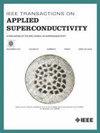Current Recycling in Heterogeneous RSFQ Circuits
IF 1.7
3区 物理与天体物理
Q3 ENGINEERING, ELECTRICAL & ELECTRONIC
引用次数: 0
Abstract
As single flux quantum (SFQ) circuit complexities scale, larger bias currents are required. The large current produces excessive heat and greatly complicates the design process. Current recycling offers a solution by reducing the required bias current through serially biased circuit blocks. Serial biasing is typically achieved in homogeneous SFQ systems where similar bias currents are required in similar circuits. Each of these homogeneous circuits is often placed on different ground planes and serially biased to reuse the bias currents. To address heterogeneous circuits with varying bias current requirements, a novel serial biasing technique is proposed. An interface between the ground planes with unequal bias current is presented that exhibits a current balancing capability. The interface supplies additional current before passing the current to the next ground plane. The ground planes are arranged in ascending order of bias current to manage the complexity of these heterogeneous circuits. Using a one bit SFQ full adder as an example, the proposed approach demonstrates several key benefits: a 49% reduction in the number of driver-receiver pairs, a 6.5% reduction in power dissipation, and a 35% reduction in bias current across a heterogeneous SFQ circuit placed on three isolated ground planes. The performance, bias current margins, and methods for current reduction are also discussed, showcasing the effectiveness of current recycling in improving the efficiency of complex heterogeneous SFQ systems.求助全文
约1分钟内获得全文
求助全文
来源期刊

IEEE Transactions on Applied Superconductivity
工程技术-工程:电子与电气
CiteScore
3.50
自引率
33.30%
发文量
650
审稿时长
2.3 months
期刊介绍:
IEEE Transactions on Applied Superconductivity (TAS) contains articles on the applications of superconductivity and other relevant technology. Electronic applications include analog and digital circuits employing thin films and active devices such as Josephson junctions. Large scale applications include magnets for power applications such as motors and generators, for magnetic resonance, for accelerators, and cable applications such as power transmission.
 求助内容:
求助内容: 应助结果提醒方式:
应助结果提醒方式:


